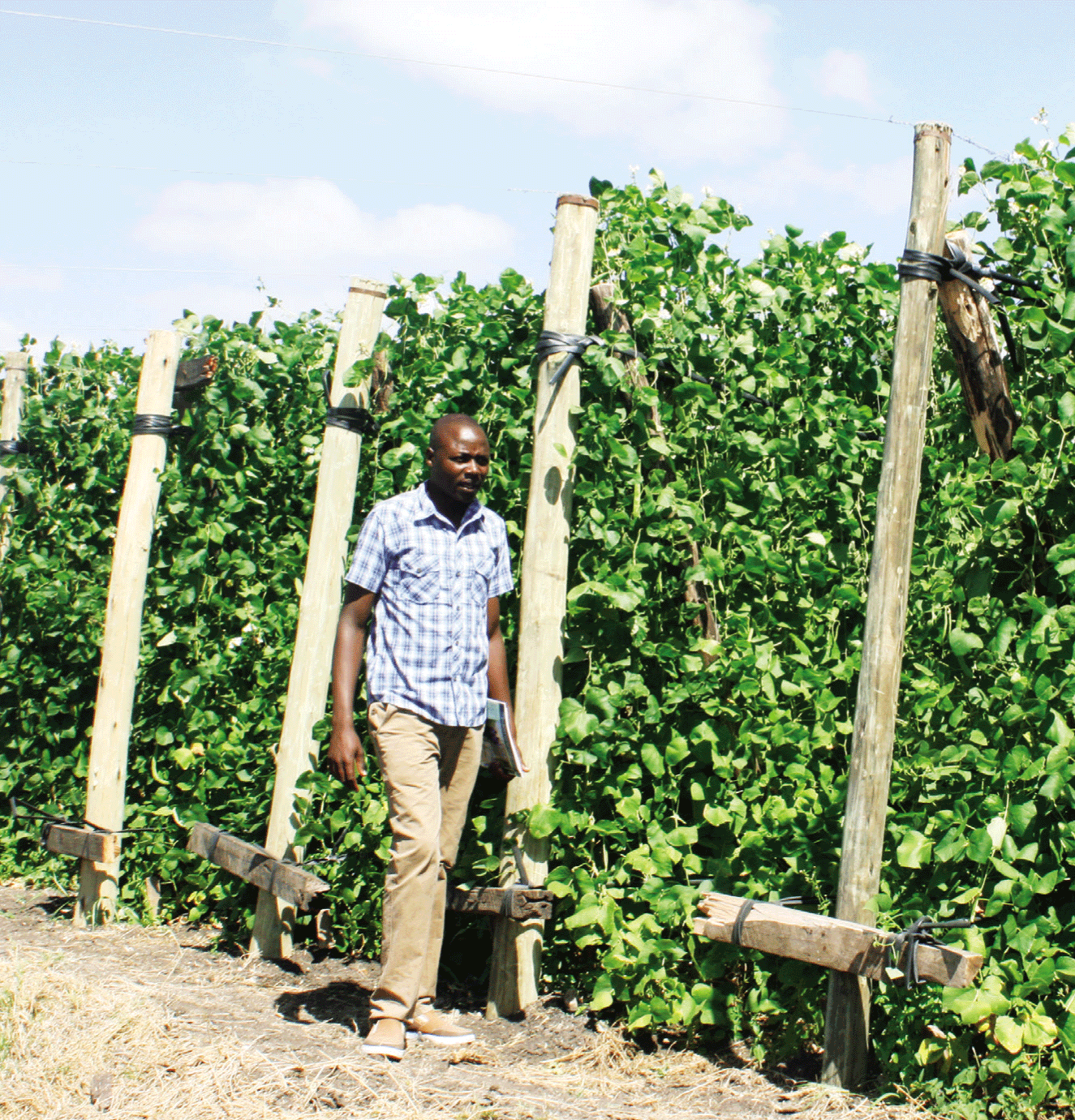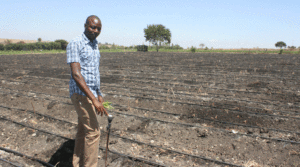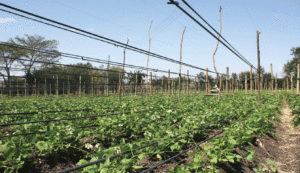
Mboga Tuu outstandingly growing Runner beans
Different ecological zones favor diverse crops; for instance, runner beans (Phaseolus Coccineus) are known to flourish in cold altitudes. Mboga Tuu, Kitengela farm, Kajiado County, is a hot and dry environment but they are farming runner beans; thanks to the newly bred Equator variety.
Abraham Kipkogei, a trained horticulturalist who is the farm manager, explained to us that runner beans can also bloom in hot areas. ‘’Naturally, this place is usually hot but we manage to cool the temperatures by installing misters,’’ he said.
Misters are specially designed sprinklers that mist water up to four meters high in a way that it forms fog patterns towering the crop hence cooling the striking sunlight rays.
Currently, the farm has dedicated several blocks which are at different stages; cumulatively amounting to five hectares, all growing of runner beans. They plant one hectare after every two weeks in a span staggering pattern to achieve a continuous harvest.


Growing runner beans begins primarily as usual by cultivation where ploughing of the land is done to achieve a fine tilth. The soil should be dry to avoid formation of hardpans resulting from compaction when done on wet soil. The land is then left for a period of 3-4 weeks to solarize. ‘’This process exposes soil-borne pathogens to high solar temperatures,’’ Abraham explained.
Afterwards, the land is then harrowed to a fine tilt and then molding is done. It’s done using a bed maker so as to level it hence achieving flat tops. The beds are raised 45 centimeters high running parallel to each other at a spacing of 60 centimeters.
Drip lines for supplying water and fertilizers are then laid on the raised beds in double rows spaced at 30-40 centimeters inter rows. Drip lines; 15cm interval discharge are suitable. Furrows are made along the drip lines at a depth of 2mm. A basal fertilizer; CRF 15.22.10 at a rate of 300kg/Ha or DAP 18.46.0 is applied in the furrows in a trailing manner at the rate of 30g/m.
Dressed Equator seeds are then placed in the furrows spaced at 15cm apart on each dripper and then covered with soil layer, 2mm thick; since they are big seeds which can easily be exposed if not well covered with soil. ‘’We dress the seeds to prevent them from being eaten by soil borne pests and also to break the seed dormancy for a uniform germination which is achieved after 10 days. Thorough watering then follows until the soil is wet. Moisture levels should be regulated since excessive watering will cause seed rot,’’ Abraham explained. Seed rate for Equator variety is 70kgs/Ha.
Equator variety do not require additional hours of supply of artificial lighting at night hence cushion the Company from incurring more on electricity bills.
When the seeds begin to sprout at week two, poles preferably 10ft; with 2ft underground while 8ft on top are installed. Poles are placed at 10m apart with fitos (thinner pole) fixed in between to offer reinforcement. A high tensile wire is then fitted from end-end poles and tightened to prevent sagging, for trailing the vines are fixed; one at the top, middle and two parallels 0.6m at the base to control the vegetation from falling off.
Two weeks after planting, the crops are usually drenched for elimination of soil borne fungus, fusarium and cutworms.
Each plant has 12 clusters and 6 to 12 pods per cluster. The crop is a heavy feeder and cannot depend on the CRF alone. At week 3-4, the crop should be top dressed with a high nitrogen fertilizer such as Urea 46%N mixed with a complete fertilizer such as polyfeed 19.19.19 or NPK 17.17.17 at a ratio of 2:0.5 that is 2 parts of urea to 0.5 parts of polyfeed or NPK.
‘’We feed them heavily at this stage to build up vegetation, they should have enough foliage to support good produce, this is called the vegetative stage, ’’ Abraham continued to explain. The crop is also sprayed at this stage to prevent rust.
Tendrils begin to elongate at vegetative stage, this is when trellising should begin. Knitting thread is suitable for this purpose and the plant coiled on it to climb and twists in a clockwise manner. The suckers that develop from the base of the bed are also re-trailed.
At the spinning stage which is week 6-7, when base flower buds start appearing, the supply of nitrogen fertilizer is decreased and fertilizers with high ammonium sulfate at the rate of 100kg/Ha should be added and sprayed with high K foliar feed. This is done to encourage more flowering. Planton hormone should be sprayed to induce and support flowers.
Week 7-podding stage: high Calcium nitrate and boron fertilizer, should be added through fertigation. Calcium increases smoothness to the young pods while Boron prevent flower abortion as well as preventing splinting of the pods through increasing cellular integrity.
From week 8 onwards, during harvesting, 50kgs of calcium nitrate and 25kgs potassium sulfate should be added after every 2 weeks.
The base pods that start flowering at week 7 are harvested in week 9 as a fly picking or clean up. Though it has no market it encourage more flowering at the middle and the top vines which are straight pods of 21-26 centimeters lengths and are very marketable.
The main harvest comes in week 10 to 13 when the 2nd generation, upper fruits are ready. At Mboga Tuu, they harvest up to five weeks achieving one to two tones in a day. The produce is stored in a cold room at 7 degrees Celsius to maintain freshness before it is transported to Kenya Horticultural Exporters (KHE), Nairobi, for packaging. The best season for runner beans, according to Kipkogei is October to January when it is in high demand.
‘’We do regular scouting of pests such as thrips, once we notice them we spray. We also ensure the blocks are free of weeds as they act as an alternate host for pests and compete with the plants for nutrients, light and space, ‘’ he elucidated.
The farm has 71 employees whose major work is picking the beans, though they also grow fine beans and chilies in this 100 acres farm. They have adopted a method where they frequently alternate chemicals to prevent resistant buildup of pest and diseases and also they crop rotate crops of different families time to time.
Runner beans are highly valued abroad due to their good taste, richness in proteins, low carbohydrates, good fat content, magnesium and other micro-nutrients.



